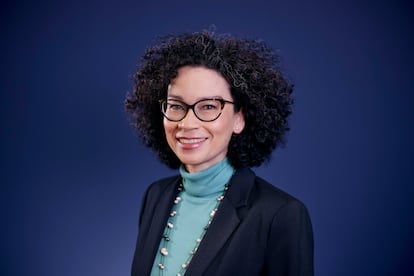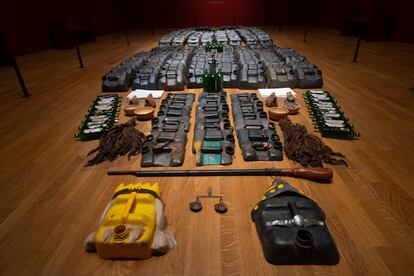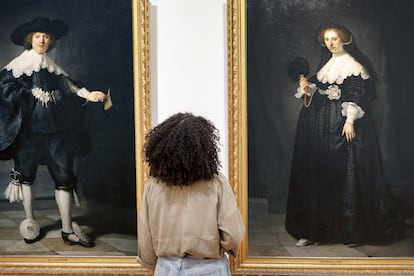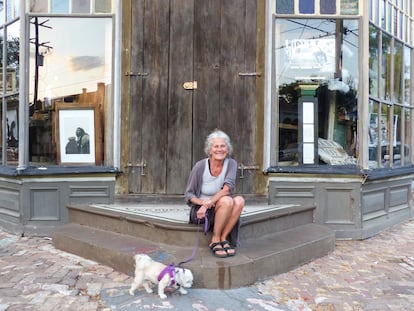Valika Smeulders, head of history at the Rijksmuseum: ‘Museums should tell the story of everyone, not just 10 people’
One of the curators of a powerful exhibition on slavery organized by the famous Netherlands institution in 2021 reflects on that process, decolonization and the change of perspective in art

The Rijksmuseum, in Amsterdam, is one of the most important museums in Europe. Visitors from all over the world go there to see Rembrandt’s The Night Watch or Vermeer’s The Milkmaid. But for some time now, the center and its works have also been the focus of attention for another reason. “We have many paintings of very important white gentlemen and ladies flanked by some Black kids. We used to ignore those young Africans, but now we study them,” says Valika Smeulders, head of the history department of this Dutch institution and one of the curators of a 2021 exhibition dedicated to slavery that caused a great impact. The expert spoke about this recently at Pública 24, an encounter between cultural professionals held in Madrid, Spain. She also spoke about what might be the most talked-about topic in the art world these days: decolonization.
Smeulders acknowledges that she is currently devoting much of her work to these issues. She was born on the island of Curaçao, in the Caribbean, but lives and works in Amsterdam. She has researched Caribbean heritage in her academic studies and recently collaborated in the return of a few pieces from the heart of Europe to Sri Lanka. In essence, her life and career alternate between the two nerve centers of the debate: a former colony and a former motherland. This background provides her with a more personal perspective, that is also complex and profound.
“The colonial period began in the 17th century and the heart of our museum comes precisely from there. In my homeland, or in Ghana, you see that it was not a time of calm and peace. We consider the East India Company commercial operators, but their representatives carried weapons. It was not a consensual business. In the Netherlands you don’t notice it until you start to learn about it, and then you detect the traces. When we looked at our collections from that perspective, we saw that it was everywhere: the government, the economy…” A similar thesis to that defended by the British teacher Catherine Hall, who Smeulders cites as one of the most pioneering and influential voices in this field.

There were plenty of reasons for Taco Dibbits, the director of the Rijksmuseum, to come up with the idea of focusing an exhibition on all of this in 2017. The subject matter is so extensive that it took four years, the creation of a think tank and the inclusion of new voices along the way, such as Smeulders herself. The expert highlights above all the extensive preliminary conversation: after announcing the project, the museum heard ideas, suggestions and concerns from the public. At the same time, it started to explain the paradigm shift to groups of its more traditional visitors. Historians and perspectives from both backgrounds converged. “We needed to have a deep academic understanding. And the museum reached out to new parts of the Netherlands that had never seen their history represented in our halls,” says the scholar.
Once the framework had been agreed upon, developing the content was just as challenging, if not more. The most incendiary opponents associate decolonization with the restitution of artistic treasures from the exploiting country to the exploited one. This is, however, only one possibility. The most noteworthy, but also the least common and, in any case, a last resort.
It all starts, as Smeulders emphasizes, with information: “It has a lot to do with the narrative. That is why we tell the story of slavery through 10 characters, including enslavers, enslaved people and people who rose up against it. We wanted everyone to feel included, and we wanted attendees to ask themselves: what would I have done if I had been born in one place, or another?” For this, it made no sense to resort only to Western documents, the history told by the victors. At the same time, Dutch law considered slaves “as objects,” without the right to read or write, according to Smeulders. Finally, they pursued their protagonists through the maze of oral sources, such as songs passed from one generation to another, and even DNA searches.

The exhibition may have marked a milestone in the artistic history of the Netherlands. Afterwards, in December 2022, came the official apology from the then Dutch prime minister, Mark Rutte, for “the slaving past of the Netherlands” in Suriname (South America) and the former Netherlands Antilles (in the Caribbean), in a televised speech where for the first time he officially defined these events as a “crime against humanity” and acknowledged that “it affects people here and now.” According to Smeulders, however, the process had been brewing long before. The scholar explains that since the beginning of the 21st century, activists “with roots in the old colonies” had been putting the debate on the table. Historians, researchers, artists and institutions joined in. Finally, even the government did. “Before, we only talked about the glory of the nation, and that is only a small part of the story. We need to include the others. We have been identifying several aspects. Now we can connect the dots,” says the expert.
The process also includes another story, different, yet similar: the artistic looting of the Jews during World War II, which has already led to the first returns by the Netherlands to the legitimate owners. The Rijksmuseum has also been working in this direction for some time. And, since 2001, the Dutch state has had the advice of an independent committee for the restitution of works obtained during or as a result of the conflict that do not legitimately belong to it. Additionally, in 2022, an identical body emerged for cases related to the colonial era.
Regarding the allusions to the heated debate that the matter of decolonization has generated in Spain (where the minister of culture, Ernest Urtasun, has expressed his support and some museums have already taken actions in this regard, while the opposition and other experts think that it is discrediting the national brand and that the debate is based on a false premise, as they believe Spain never had colonies), Smeulders avoids expressing an opinion. Instead, she steers the conversation back to her own country: “The owner of the Rijksmuseum collection is the state. But we look after it, and we research it. We need to know more, and we couldn’t do it alone. We contacted the countries that could claim some objects, and their experts. It’s the beginning of something that is getting bigger and bigger. The display case where the pieces that we returned to Sri Lanka were shown still tells our common history, but with other works.”
For Smeulders, a deep, inclusive and difficult conversation is necessary. “This is not something that gets resolved overnight. In Dutch, we say ‘there is no shine without friction,’” she smiles, and emphasizes the importance of questioning the perspective that has always dominated: “The role of the curator is changing. It now includes more research. When we organize an exhibition, we want to investigate from scratch and achieve the maximum possible knowledge. Pay more attention to what the female artists were doing, too; to the rural areas, instead of just looking at the big cities… museums should tell the story of everyone, not just 10 people.” Among other things, because they are always the same people.
Sign up for our weekly newsletter to get more English-language news coverage from EL PAÍS USA Edition
Tu suscripción se está usando en otro dispositivo
¿Quieres añadir otro usuario a tu suscripción?
Si continúas leyendo en este dispositivo, no se podrá leer en el otro.
FlechaTu suscripción se está usando en otro dispositivo y solo puedes acceder a EL PAÍS desde un dispositivo a la vez.
Si quieres compartir tu cuenta, cambia tu suscripción a la modalidad Premium, así podrás añadir otro usuario. Cada uno accederá con su propia cuenta de email, lo que os permitirá personalizar vuestra experiencia en EL PAÍS.
¿Tienes una suscripción de empresa? Accede aquí para contratar más cuentas.
En el caso de no saber quién está usando tu cuenta, te recomendamos cambiar tu contraseña aquí.
Si decides continuar compartiendo tu cuenta, este mensaje se mostrará en tu dispositivo y en el de la otra persona que está usando tu cuenta de forma indefinida, afectando a tu experiencia de lectura. Puedes consultar aquí los términos y condiciones de la suscripción digital.
More information

Their stories were lost to slavery. Now DNA is writing them
Archived In
Últimas noticias
Venezuela authorizes the release of another 87 political prisoners
There is as much life left to discover on planet Earth as that which is already known
Dozens presumed dead, around 100 injured in fire at Swiss Alps bar during New Year’s celebration
Is porn for women different from conventional porn? We spoke to those who make it
Most viewed
- David King, chemist: ‘There are scientists studying how to cool the planet; nobody should stop these experiments from happening’
- Reinhard Genzel, Nobel laureate in physics: ‘One-minute videos will never give you the truth’
- Oona Chaplin: ‘I told James Cameron that I was living in a treehouse and starting a permaculture project with a friend’
- Sinaloa Cartel war is taking its toll on Los Chapitos
- The Interoceanic Train, the Mexican alternative to the Panama Canal










































